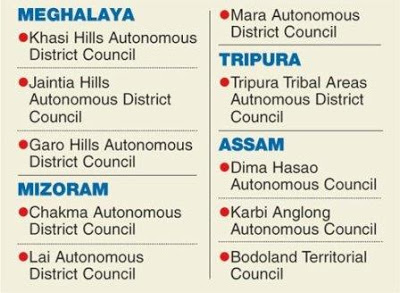Indian Polity
Demand for 6th Schedule Status: Arunachal Pradesh
- 14 Aug 2020
- 5 min read
Why in News
The recent revival of the demand for two autonomous councils in Arunachal Pradesh has led to the call for bringing the entire Arunachal Pradesh under the ambit of the 6th Schedule or Article 371 (A) of the Constitution.
- Currently Arunachal Pradesh is neither under 5th Schedule nor under 6th Schedule. It is under the Inner Line Permit (ILP) system.
- The 6th Schedule is applied in Assam, Meghalaya, Mizoram and Tripura.
- The 5th Schedule areas are declared in the States of Andhra Pradesh, Telangana, Chhattisgarh, Gujarat, Himachal Pradesh, Jharkhand, Madhya Pradesh, Maharashtra, Odisha and Rajasthan.
- On the other hand, Article 371 A is applied in Nagaland which provides special status to Nagaland.
Key Points
- 6th Schedule:
- The 6th Schedule of the Constitution provides for the administration of tribal areas in Assam, Meghalaya, Tripura and Mizoram to safeguard the rights of the tribal population in these states. This special provision is provided under Article 244(2) and Article 275(1) of the Constitution.
- The tribes in the above states have not assimilated much with the life and ways of the other people in these states. These areas still have the presence of anthropological specimens.
- Based on the reports of the Bordoloi Committee formed by the Constituent Assembly, the 6th Schedule was formulated to provide limited autonomy to the tribal regions of North-East.
- The committee report stated that there was a need for a system of administration that would allow tribal areas to become developed.
- The report also called for the protection of these tribal areas from exploitation by the people in the plains and preserving their distinct social customs.
- The 6th Schedule of the Constitution provides for the administration of tribal areas in Assam, Meghalaya, Tripura and Mizoram to safeguard the rights of the tribal population in these states. This special provision is provided under Article 244(2) and Article 275(1) of the Constitution.
- Administration in the 6th Schedule:
- The tribal areas in the 6th Schedule area have been constituted as autonomous districts. The autonomous districts have been given varying degrees of autonomy within the State Legislature.
- The tribals have been given freedom to exercise legislative and executive powers through an autonomous regional council and autonomous district councils (ADCs).
- The ADCs are empowered with civil and judicial powers. They can also make laws on matters like land, forests, fisheries, social security, etc. with due approval from the governor.
- The Acts passed by Parliament and state legislatures may or may not be levied in these regions unless the President and the governor gives her or his approval, with or without modifications in the laws for the autonomous regions.
- Governor’s Control:
- Despite various degrees of autonomy, the 6th Schedule area does not fall outside the executive authority of the state concerned.
- The governor is empowered to organise and re-organise the autonomous districts. He can increase or decrease the areas of autonomous districts or change their names or define their boundaries and so on.
- If there are different tribes in an autonomous district, the governor can also divide the district into several autonomous regions.
- The tribal areas in the 6th Schedule area have been constituted as autonomous districts. The autonomous districts have been given varying degrees of autonomy within the State Legislature.
- Composition of Autonomous Councils:
- Each autonomous district and regional council consists of not more than 30 members, of which four are nominated by the governor and the rest via elections. All of them remain in power for a term of five years.
- However, the Bodoland Territorial Council is an exception as it can constitute up to 46 members.
- Article 371 A:
- The Acts of Parliament relating to the following matters would not apply to Nagaland unless decided by the State Legislative Assembly:
- Religious or social practices of the Nagas.
- Naga customary law and procedure.
- Administration of civil and criminal justice involving decisions according to Naga customary law.
- Ownership and transfer of land and its resources.
- The Acts of Parliament relating to the following matters would not apply to Nagaland unless decided by the State Legislative Assembly:






